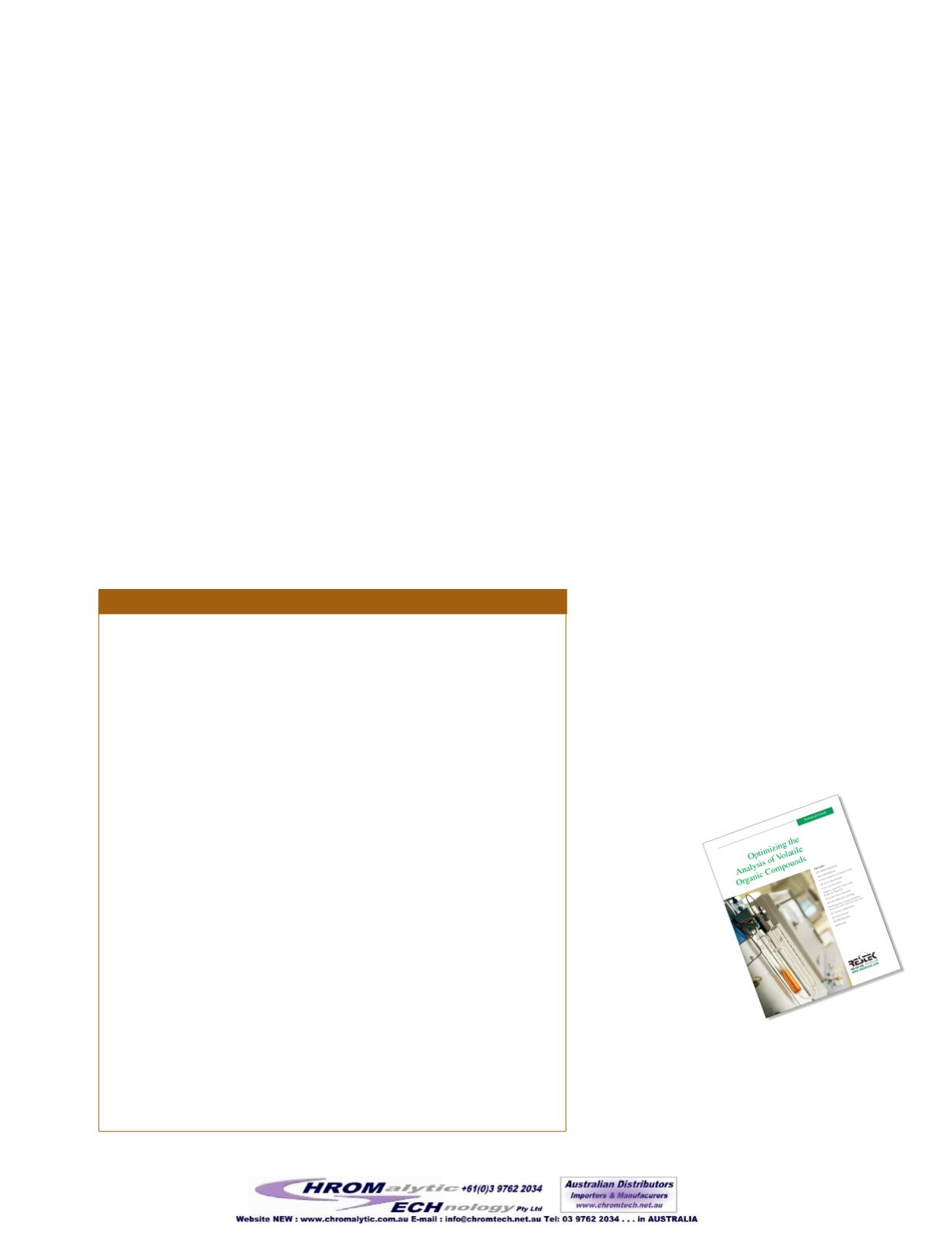
Restek Corporation • (800) 356-1688 •
Purge andTrapProcedures
Table 4 summarizes the purge and trap conditions used for recovering oxygenates from gasoline. Sampleswere heated using the
Infra-Sparge
™
sample heater on anO.I. 4560 concentrator. Theminimum purge temperature effective for detectingTBA at a concen-
tration of 25ppb in 10mL of water was 40°C. Purge flow ratewas carefully adjusted to 38mL/min.; lower flows dramatically affect
recovery of the brominated compounds, higher flows contribute to analyte breakthrough and excessivewater retention on the trap.
Analytical Procedures
AnAgilent 5890 Series II GC coupledwith anAgilent 5971AGC/MS detector fittedwith aK&M electronmultiplier was used for
the analysis. Helium carrier gaswas adjusted to 1.3mL/min. constant flow. The oven temperature programwas optimized as follows:
35°C (hold 7min.) to 90°C@ 4°C/min. (hold 0min.), to 220°C@ 45°C/min. (hold 1min.).Analysis timewas 25minutes; cycle
timewas 30minutes. TheMSwas set for full scan from 35amu to 260amu andwas initially tunedwith FC-43 or PFTBA calibration
gas, followed byBFB.A 30m x 0.25mm x 1.4µmRtx
®
-VMS column (cat.# 19915) was used for the separations.
Standards
The five points of the calibrationwere 5, 10, 20, 40, and 80 ppb, with internal standards (IS) and surrogate standards (SS) added to
each calibration standard at 20ppb. Intermediate standardsweremade separately for each calibration point, tomaintain equal
amounts ofmethanol added to the 10mL volume of water. Sampleswere spiked andwere transferred to the concentrator by hand.
Calibrationwas performed using the analyte list inTable 3, but all compounds shown in Figure 2were added in order to check for
critical coelutions between oxygenates andMethod 8260B target compounds. Calibration verification standards (CVS) were added at
10ppb; recoverieswerewithin 20% of expected values. Two blankswere analyzed, followed by a 5ppbQC standard to verify recov-
eries at the low point of the curve.
4
Referencematerials used are listed inTable 5.
Gasoline-SpikedSamples
Analysis of the 5ppbQC standardwas followed by analysis of a 1ppm non-oxygenated gasoline standard, then by analysis of the
non-oxygenated standardwith 5ppb of each target compound added. % recoveries for the 5ppb oxygenate standardswere calculated
from this high concentration gasolinematrix. The final standard analyzedwas 1ppm (unweathered) unleaded gasoline.All samples
were spikedwith the appropriate IS and SS. The calibration curve passedEPA 8260 criteria for response factors and relative standard
deviations. Only two compounds in the test set showed poor response: acetone andTBA.
Table 4:
Purge and trap conditions for recovering oxygenates from
gasoline (O.I. 4560 concentrator).
Trap:
#10 (Tenax
®
/silica gel/carbonmolecular sieve)
PurgeTime:
11min.
Purge FlowRate:
38mL/min.
Desorb FlowRate: 32mL/min.
DesorbTime:
1.0min.
BakeTime:
10min.
Sample Size:
10mL
WaterManagement: 110°C purge, 0°C desorb, 240°C bake
Split Ratio:
1:25
Temperatures:
Sample:
40°C
Trap:
20°C purge, 190°C desorb, 210°C bake
6-PortValve:
110°C
Transfer Line:
110°C
SpargeMount:
45°C
Desorb Preheat:
150°C
ValveManifold:
50°C
Other Conditions:
pre-purge, pre-heat, dry purgeOFF
Conditions suggested byO.I. Analytical.
Optimizing theAnalysis
of VolatileOrganicCompounds
Our technical guide is a concise, thorough overview to
analyzing volatile organics in environmental samples:
✔
Purge and trap theory - adsorbents and traps -
troubleshooting
✔
GC system configurations for narrow-bore or
wide-bore capillary columns
✔
Optimizing detection systems
Many chromatograms show how changes in
chromatographic parameters achieve
specific goals. Invaluable
information for new
chromatographers;
experienced analysts
can find ideas and justi-
fication for updating
methodology.
72 pages.
Free on request - ask for
lit. cat.# 59887A, or visit
our website.


